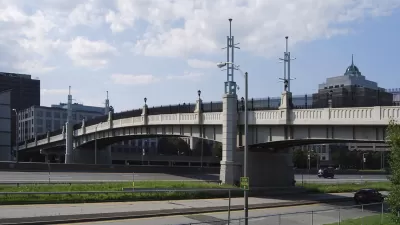Landscape architect James Corner pushes the envelope of the field to create innovative projects like The High Line Park in New York. 'There is a desperate need for a different kind of professional who isn’t so Balkanized.'
"Corner has spent the last 25 years becoming that guy in a deliberate attempt to reinvent the field of landscape architecture by pushing aside its second-fiddle status and antiurban tendencies and claiming a more ambitious agenda: to design the postindustrial city. Rather than wielding bushes and trees-the proverbial parsley around the roast of proper architecture-landscape architects are, as Corner sees it, the best prepared to tackle the complex, large-scale, often environmentally damaged sites that have become the hallmark of urban regeneration. He approaches them with the intellectual assurance of a philosopher and the political bravado of a power broker. "I don't want to be embarrassed to be a landscape architect because we're thought of as tree people who come in at the end of the day," he says.
The first built example of that ambition is just now being realized with the opening next month of sections of the High Line, the elevated-freight-railway-turned-park on the West Side of Manhattan. The project has been charmed from the beginning, blessed with astute neighborhood activists, strong political will, and plenty of private money. And yet Corner has constantly had to battle the misconception that the architects, Diller Scofidio + Renfro-his subcontractors-did the heavy lifting while his team merely chose the shrubbery. "In every project we've initiated, we've led, we've had architects and engineers and other experts be part of our team," Corner says. "Professionally speaking, that's a big advance for a field that's normally reticent.'"
FULL STORY: The Long View

Study: Maui’s Plan to Convert Vacation Rentals to Long-Term Housing Could Cause Nearly $1 Billion Economic Loss
The plan would reduce visitor accommodation by 25,% resulting in 1,900 jobs lost.

North Texas Transit Leaders Tout Benefits of TOD for Growing Region
At a summit focused on transit-oriented development, policymakers discussed how North Texas’ expanded light rail system can serve as a tool for economic growth.

Why Should We Subsidize Public Transportation?
Many public transit agencies face financial stress due to rising costs, declining fare revenue, and declining subsidies. Transit advocates must provide a strong business case for increasing public transit funding.

How to Make US Trains Faster
Changes to boarding platforms and a switch to electric trains could improve U.S. passenger rail service without the added cost of high-speed rail.

Columbia’s Revitalized ‘Loop’ Is a Hub for Local Entrepreneurs
A focus on small businesses is helping a commercial corridor in Columbia, Missouri thrive.

Invasive Insect Threatens Minnesota’s Ash Forests
The Emerald Ash Borer is a rapidly spreading invasive pest threatening Minnesota’s ash trees, and homeowners are encouraged to plant diverse replacement species, avoid moving ash firewood, and monitor for signs of infestation.
Urban Design for Planners 1: Software Tools
This six-course series explores essential urban design concepts using open source software and equips planners with the tools they need to participate fully in the urban design process.
Planning for Universal Design
Learn the tools for implementing Universal Design in planning regulations.
City of Santa Clarita
Ascent Environmental
Institute for Housing and Urban Development Studies (IHS)
City of Grandview
Harvard GSD Executive Education
Toledo-Lucas County Plan Commissions
Salt Lake City
NYU Wagner Graduate School of Public Service





























